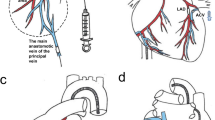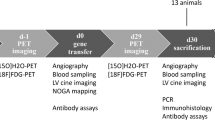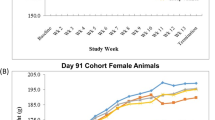Abstract
Catheter-based percutaneous transluminal gene delivery (PTGD) into the coronary artery still falls behind the expectations of an efficient myocardial gene delivery system. In this study gene delivery was applied by selective pressure-regulated retroinfusion through the coronary veins to prolong adhesion of replication defective adenovirus within the targeted myocardium. Adenoviral vectors consisted either of luciferase (Ad.rsv-Luc) or β-galactosidase (Ad.rsv-βGal) reporter gene under control of an unspecific promotor derived from the Rous sarcoma virus (RSV). In this pig model, selective retrograde gene delivery into the anterior cardiac vein during a brief period of ischemia substantially increased reporter gene expression in the targeted myocardium (LAD region) compared with antegrade delivery as a control. Repeated retrograde delivery during two periods of brief ischemia resulted in a more homogeneous transmural expression predominantly observed in cardiomyocytes (X-gal-staining). In the nontargeted myocardium (CX region) there was no evidence for adenoviral transfection. From our data we infer that selective pressure-regulated retroinfusion is a promising approach for efficient percutaneous transluminal gene delivery to the myocardium.
This is a preview of subscription content, access via your institution
Access options
Subscribe to this journal
Receive 12 print issues and online access
$259.00 per year
only $21.58 per issue
Buy this article
- Purchase on Springer Link
- Instant access to full article PDF
Prices may be subject to local taxes which are calculated during checkout







Similar content being viewed by others
References
Guzman RJ et al. Efficient gene transfer into myocardium by direct injection of adenovirus vectors Circ Res 1993 73: 1202–1207
French BA, Mazur W, Geske RS, Bolli R . Direct in vivo gene transfer into porcine myocardium using replication-deficient adenoviral vectors Circulation 1994 90: 2414–2424
French BA et al. Percutaneous transluminal in vivo gene transfer by recombinant adenovirus in normal porcine coronary arteries, atherosclerotic arteries, and two models of coronary restenosis Circulation 1994 90: 2402–2413
Hajjar RJ, Kang JX, Gwathmey JK, Rosenzweig A . Physiological effects of adenoviral gene transfer of sarcoplasmic reticulum calcium ATPase in isolated rat myocytes Circulation 1997 95: 423–429
Franz WM, Rothmann R, Frey N, Katus HA . Analysis of tissue-specific gene delivery by recombinant adenoviruses containing cardiac-specific promoters Cardiovasc Res 1997 35: 560–566
Magovern CJ et al. Direct in vivo gene transfer to canine myocardium using a replication-deficient adenovirus vector Ann Thorac Surg 1996 62: 425–433
Feldman LJ, Steg G . Optimal techniques for arterial gene transfer Cardiovasc Res 1997 35: 391–404
Steg PG et al. Arterial gene transfer to rabbit endothelial and smooth muscle cells using percutaneous delivery of an adenoviral vector Circulation 1994 90: 1648–1656
Barr E et al. Efficient catheter-mediated gene transfer into the heart using replication-deficient adenovirus Gene Therapy 1994 1: 51–58
Lamping KG et al. Intrapericardial administration of adenovirus for gene transfer Am J Physiol 1997 272: H310–317
March KL et al. Efficient in vivo catheter-based pericardial gene transfer mediated by adenoviral vectors Clin Cardiol 1999 22: I23–I29
Giordano FJ et al. Adenovirus-mediated gene transfer reconstitutes depressed sarcoplasmic reticulum Ca2+-ATPase levels and shortens prolonged cardiac myocyte Ca2+ transients Circulation 1997 96: 400–403
Rothmann T et al. Heart muscle-specific gene expression using replication defective recombinant adenovirus Gene Therapy 1996 3: 919–926
Hatori N, Sjoquist PO, Regardh C, Ryden L . Pharmacokinetic analysis of coronary sinus retroinfusion in pigs. Ischemic myocardial concentrations in the left circumflex arterial area using metoprolol as a tracer Cardiovasc Drugs Ther 1991 5: 1005–1010
Ryden L et al. Pharmacokinetic analysis of coronary venous retroinfusion: a comparison with anterograde coronary artery drug administration using metoprolol as a tracer JACC 1991 18: 603–612
Haga Y et al. Ischemic and nonischemic tissue concentrations of felodipine after coronary venous retroinfusion during myocardial ischemia and reperfusion: an experimental study in pigs J Cardiovasc Pharmacol 1994 24: 298–302
von Degenfeld G, Giehrl W, Boekstegers P . Targeting of dobutamine to ischemic myocardium without systemic effects by selective suction and pressure-regulated retroinfusion Cardiovasc Res 1997 35: 233–240
Boekstegers P, von Degenfeld G, Giehrl W, Steinbeck G . Selective suction and pressure-regulated retroinfusion: an effective and safe approach to retrograde protection against myocardial ischemia in patients undergoing normal and high risk percutaneous transluminal coronary angioplasty JACC 1998 31: 1525–1523
Boekstegers P et al. Preservation of regional myocardial function and myocardial oxygen tension during acute ischemia in pigs: comparison of selective synchronized suction and retroinfusion of coronary veins (SSR) to synchronized coronary venous retroperfusion (SRP) J Am Coll Cardiol 1994 23: 459–469
Wright MJ et al. β-Galactosidase staining following intracoronary infusion of cationic liposomes in the in vivo rabbit heart is produced by microinfarction rather than effective gene transfer: a cautionary tale Gene Therapy 1998 5: 301–308
Donahue JK et al. Ultrarapid, highly efficient viral gene transfer to the heart Proc Natl Acad Sci USA 1997 94: 4664–4668
Donahue JK et al. Acceleration of widespread adenoviral gene transfer to intact hearts by coronary perfusion with low calcium and serotonin Gene Therapy 1998 5: 630–634
Pernow J et al. The protective effect of L-arginine on myocardial injury and endothelial function following ischemia and reperfusion in the pig Eur Heart J 1994 15: 1712–1719
Franz WM et al. Heart-specific targeting of firefly luciferase by the myosin light chain-2 promotor and developmental regulation in transgenic mice Circ Res 1993 73: 629–638
Griscelli F et al. Expression from cardiomyocyte-specific promoter after adenovirus-mediated gene transfer in vitro and in vivo CR Acad Sci III 1997 320: 103–112
Kochanek S et al. A new adenoviral vector: replacement of all viral coding sequences with 28kb of DNA independently expressing both full-length dysthrophin and β-galactosidase Proc Natl Acad Sci USA 1996 93: 5731–5736
Parks RJ et al. A helper-dependent adenovirus vector system: removal of helper virus by Cre-mediated excision of the viral packing signal Proc Natl Acad Sci USA 1996 93: 13565–13570
Fox JC . Cardiovascular gene therapy: current concepts Ther Drug Monit 1996 18: 410–422
Melillo G et al. Gene therapy for collateral development Cardiovasc Res 1997 35: 480–490
von Degenfeld G, Heinrich D, Giehrl W, Boekstegers P . Comparison of Pura-Vario and Palmaz-Schatz stents following implantation using normal and high pressure in pigs: immediate and late results assessed by 3-dimensional IVUS Z Kardiol 1999 (in press)
Bradford MM . A rapid and sensitive method for the quantification of microgram quantities of protein utilizing the principle of protein-dye binding Anal Biochem 1976 72: 248–254
Author information
Authors and Affiliations
Rights and permissions
About this article
Cite this article
Boekstegers, P., von Degenfeld, G., Giehrl, W. et al. Myocardial gene transfer by selective pressure-regulated retroinfusion of coronary veins. Gene Ther 7, 232–240 (2000). https://doi.org/10.1038/sj.gt.3301079
Received:
Accepted:
Published:
Issue Date:
DOI: https://doi.org/10.1038/sj.gt.3301079
Keywords
This article is cited by
-
Cardiac vein retroinjections provide an efficient approach for global left ventricular gene transfer with adenovirus and adeno-associated virus
Scientific Reports (2024)
-
Cardiac gene therapy: are we there yet?
Gene Therapy (2016)



